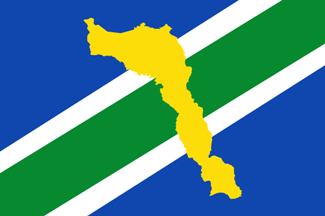 image located by Valentin Poposki, 2 April 2020
image located by Valentin Poposki, 2 April 2020
Last modified: 2020-05-03 by ian macdonald
Keywords: amapa | laranjal do jari | map |
Links: FOTW homepage |
search |
disclaimer and copyright |
write us |
mirrors
 image located by Valentin Poposki, 2 April 2020
image located by Valentin Poposki, 2 April 2020
Diagonally divided with a rising green diagonal on white on blue, extending obliquely across it a deep yellow map of the municipality, fimbriated white.
The civic symbols of the municipality of Laranjal de Jari are the municipal
flag, coat of arms and anthem, all prescribed by Law No. 004/95, 11 January
1995.
The municipal flag is of rectangular shape (1.38 x 0.90 m), with
colors yellow, white, blue and green. In the middle, the yellow map of the
municipality represents the resources of the soil and the underground. The
color white, used to outline of the map and to separate the green stripe from
the blue fields, represents peace and trust that people of Laranjal do Jari have
in the future. The transversal green stripe, ascending form the lower left to
the upper right corner, broken in the middle by the white-outlined yellow map,
represents the forest resources of the municipality. The blue fields, in the
upper left part and the lower right part, bordered by white stripes parallel to
the green stripe, represent river Jari and its importance for the development of
the region.
The municipal arms of Laranjal de Jari are made of an octagonal shield. The
central part of the shield includes a ring, whose upper part is inscribed with
the name of the municipality and lower part charged with the date of its
creation (17.12.87), the name and the date being separated by two doves. The
central disk is divided into four equal parts. The colors of the municipal arms
are green, white, black, yellow and blue. In the first quarter appears on a
green background a chestnut tree with seven burs in the foliage and one on the
ground, and a man breaking burs in the shadow of the tree. These elements
represent the importance of chestnut extraction for the municipality. In the
second quarter appears on a blue background St. Anthony Falls, representing the
vivid environment of the municipality and the most important tourist site of the
region. In the third quarter appear on a blue background three busts and two
hands shaking each other in a fraternal gesture of compromise and progress,
representing those who have left their rural home for a better life within the
great Laranjalan family. In the fourth quarter, on a green background, a bovine
head represents cattle-breeding in the municipality.
The very same Law
No. 004/95, Chapter IV, Article 13, prescribed the teaching of the design and
meaning of the municipal flag and arms in all educational, official or
particular institutes in the municipality of Laranjal do Jari.
Source:
ftp://ftp.cprm.gov.br/pub/pdf/laranjal/infraestrutura/infra_3simbolos.pdf
Ivan Sache, 30 January 2010